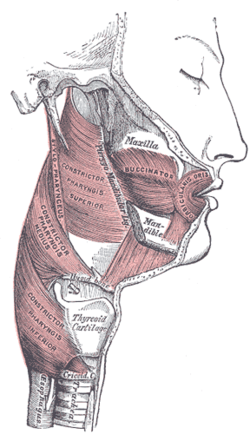Parapharyngeal space
| Parapharyngeal space | |
|---|---|

Lateral head anatomy detail
|
|

Muscles of the pharynx and cheek.
|
|
| Details | |
| Identifiers | |
| Latin | Spatium lateropharyngeum, spatium pharyngeum laterale, spatium parapharyngeum |
| TA | A05.3.01.119 |
| FMA | 84967 |
|
Anatomical terminology
[]
|
|
The parapharyngeal space (also termed the lateral pharyngeal space), is a potential space in the head and the neck. It has clinical importance in otolaryngology due to parapharyngeal space tumours and parapharyngeal abscess developing in this area. It is also a key anatomic landmark for localizing disease processes in the surrounding spaces of the neck; the direction of its displacement indirectly reflects the site of origin for masses or infection in adjacent areas, and consequently their appropriate differential diagnosis.
The parapharyngeal space is shaped like an inverted pyramid. Medial and inferior to the parapharyngeal space is the carotid sheath, containing the internal carotid artery and cranial nerves IX, X and XI. Behind both the parapharyngeal space and carotid space lies the retropharyngeal space, and deep to this a potential space known as the danger space. The danger space serves as an important pathway for complicated infections of the posterior pharynx to enter the chest and spinal column. Anterior to the parapharyngeal space is the masticator space which contains the lower dental row, muscles of mastication, the inferior alveolar nerve as well as branches of cranial nerve V. Lateral to the parapharyngeal space lies the parotid space, which contains the parotid gland, the external carotid artery and cranial nerve VII. Although initial evaluation is typically by physical exam and endoscopy, follow up with CT and MRI usually is needed if surgical intervention is planned.
...
Wikipedia
